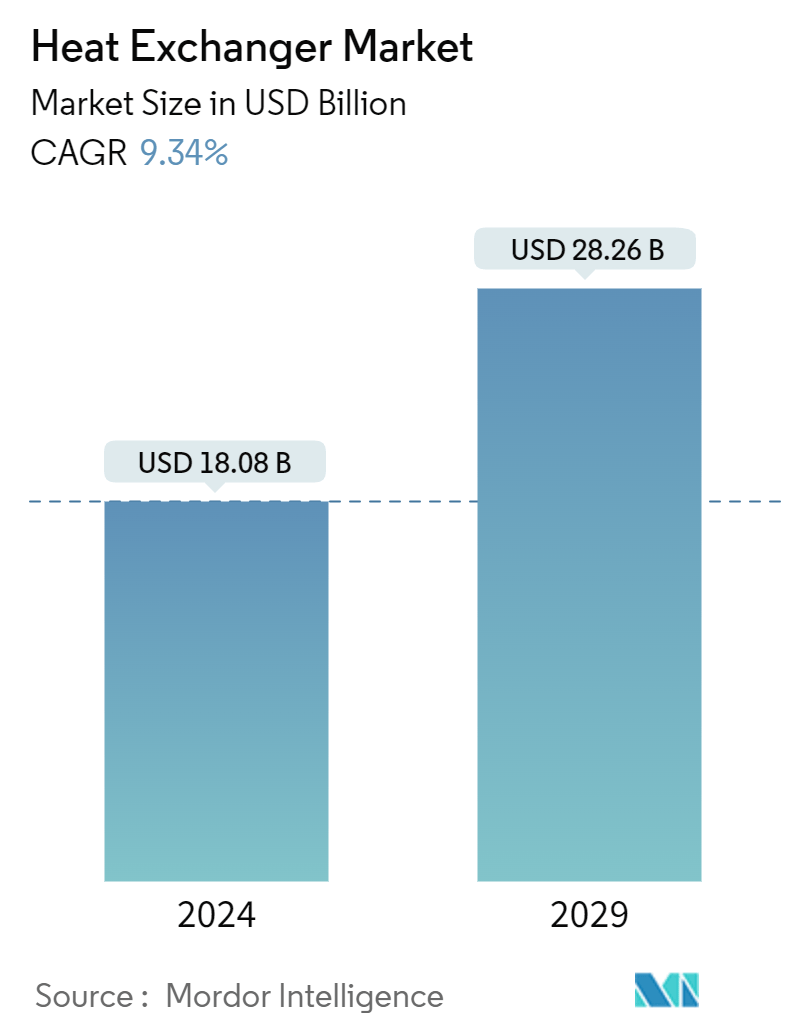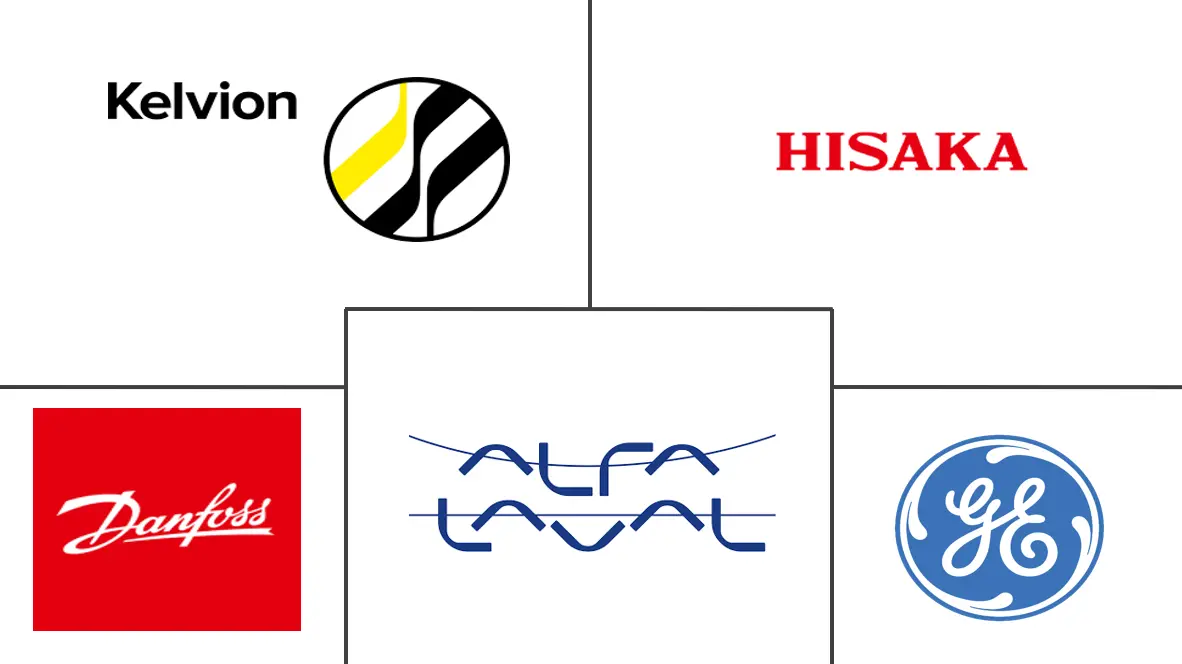Market Size of Heat Exchanger Industry

| Study Period | 2020 - 2029 |
| Market Size (2024) | USD 18.08 Billion |
| Market Size (2029) | USD 28.26 Billion |
| CAGR (2024 - 2029) | 9.34 % |
| Fastest Growing Market | Asia Pacific |
| Largest Market | Asia Pacific |
| Market Concentration | Low |
Major Players
*Disclaimer: Major Players sorted in no particular order |
Heat Exchanger Market Analysis
The Heat Exchanger Market size is estimated at USD 18.08 billion in 2024, and is expected to reach USD 28.26 billion by 2029, growing at a CAGR of 9.34% during the forecast period (2024-2029).
- Over the medium term, increasing industrial applications, expansions, and the development of new power plants will likely drive the market during the forecast period.
- On the other hand, increasing renewable energy, which rarely requires a heat exchanger, is expected to impact the market negatively.
- However, increasing industrialization and urbanization in developing countries, such as China and India, require more power generation, which is expected to create an opportunity for the heat exchanger market.
- Asia-Pacific is expected to dominate the heat exchanger market due to its increasing industrial development in China, Japan, South Korea, and India.
Heat Exchanger Industry Segmentation
Heat exchangers are devices that transfer heat from one medium to another. These media can be either a gas, a liquid, or a combination of the two. To prevent mixing, the media may be separated by a solid wall or in direct contact. Heat exchangers must supply heating and cooling to meet a process's needs.
The heat exchanger market is segmented by construction type, end user, and geography. By construction type, the market is segmented into shell and tube, plate frame, and other construction types. By end user, the market is segmented into the oil and gas industry, power generation, chemical, food and beverages, and other end users. The report also covers the market size and forecasts for the heat exchanger market across major regions such as North America, Europe, Asia-Pacific, South America, and the Middle East and Africa. For each segment, the market sizing and forecasts are done based on revenue (USD).
| Construction Type | |
| Shell and Tube | |
| Plate Frame | |
| Other Construction Types |
| End User | |
| Oil and Gas Industry | |
| Power Generation | |
| Chemical | |
| Food and Beverages | |
| Other End Users |
| Geography | ||||||||||
| ||||||||||
| ||||||||||
| ||||||||||
| ||||||||||
|
Heat Exchanger Market Size Summary
The heat exchanger market is poised for significant growth over the forecast period, driven by increasing industrial applications and the development of new power plants. The demand for heat exchangers is expected to rise, particularly in the power generation sector, where they are essential for collecting heat from waste gases to generate electricity. This demand is fueled by the growing need for electricity in both residential and industrial sectors, especially in developing countries like China and India, where industrialization and urbanization are on the rise. However, the market may face challenges due to the increasing reliance on renewable energy sources, which typically require fewer heat exchangers. Despite this, the expansion of power generation projects, including nuclear and coal-fired plants, is anticipated to create substantial opportunities for the heat exchanger market.
Asia-Pacific is expected to maintain its dominance in the heat exchanger market, supported by ongoing industrial development and numerous power projects in countries such as China, Japan, South Korea, and India. The region's market growth is further bolstered by investments from key players aiming to expand their regional presence. Notable developments include the expansion of production facilities by companies like LU-VE Group in China and the construction of new coal and nuclear power plants by NTPC Ltd and the Nuclear Power Corporation of India Ltd. These initiatives are expected to drive the demand for heat exchangers in the region. The market is moderately fragmented, with major players like Alfa Laval AB, Danfoss AS, and General Electric Company actively contributing to innovation and product development, such as the introduction of new heat exchanger technologies for various applications.
Heat Exchanger Market Size - Table of Contents
-
1. MARKET OVERVIEW
-
1.1 Introduction
-
1.2 Market Size and Demand Forecast in USD billion, till 2029
-
1.3 Recent Trends and Developments
-
1.4 Government Policies and Regulations
-
1.5 Market Dynamics
-
1.5.1 Drivers
-
1.5.1.1 Increasing Industrialization across the World
-
1.5.1.2 Expansion and Development of New Power Plants
-
-
1.5.2 Restraints
-
1.5.2.1 Increasing Adoption of Renewable Energy
-
-
-
1.6 Supply Chain Analysis
-
1.7 Porter's Five Forces Analysis
-
1.7.1 Bargaining Power of Suppliers
-
1.7.2 Bargaining Power of Consumers
-
1.7.3 Threat of New Entrants
-
1.7.4 Threat of Substitute Products and Services
-
1.7.5 Intensity of Competitive Rivalry
-
-
-
2. MARKET SEGMENTATION
-
2.1 Construction Type
-
2.1.1 Shell and Tube
-
2.1.2 Plate Frame
-
2.1.3 Other Construction Types
-
-
2.2 End User
-
2.2.1 Oil and Gas Industry
-
2.2.2 Power Generation
-
2.2.3 Chemical
-
2.2.4 Food and Beverages
-
2.2.5 Other End Users
-
-
2.3 Geography
-
2.3.1 North America
-
2.3.1.1 United States
-
2.3.1.2 Canada
-
2.3.1.3 Mexico
-
2.3.1.4 Rest of North America
-
-
2.3.2 Europe
-
2.3.2.1 United Kingdom
-
2.3.2.2 Germany
-
2.3.2.3 France
-
2.3.2.4 Russia
-
2.3.2.5 NORDIC
-
2.3.2.6 Italy
-
2.3.2.7 Spain
-
2.3.2.8 Rest of Europe
-
-
2.3.3 Asia-Pacific
-
2.3.3.1 India
-
2.3.3.2 China
-
2.3.3.3 Japan
-
2.3.3.4 Australia
-
2.3.3.5 Thailand
-
2.3.3.6 Indonesia
-
2.3.3.7 Malaysia
-
2.3.3.8 Rest of Asia-Pacific
-
-
2.3.4 South America
-
2.3.4.1 Brazil
-
2.3.4.2 Argentina
-
2.3.4.3 Colombia
-
2.3.4.4 Rest of South America
-
-
2.3.5 Middle East and Africa
-
2.3.5.1 United Arab Emirates
-
2.3.5.2 Saudi Arabia
-
2.3.5.3 Qatar
-
2.3.5.4 Nigeria
-
2.3.5.5 South Africa
-
2.3.5.6 Egypt
-
2.3.5.7 Rest of the Middle East and Africa
-
-
-
Heat Exchanger Market Size FAQs
How big is the Heat Exchanger Market?
The Heat Exchanger Market size is expected to reach USD 18.08 billion in 2024 and grow at a CAGR of 9.34% to reach USD 28.26 billion by 2029.
What is the current Heat Exchanger Market size?
In 2024, the Heat Exchanger Market size is expected to reach USD 18.08 billion.

